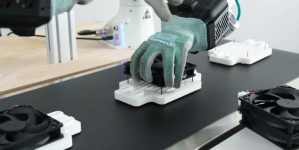-
AI startup Onton raises $7.5M to reinvent the way the world discovers and decides what to buy - November 26, 2025
-
Forklift Market Positions for Recovery as Confidence Expected to Build from 2026 - November 26, 2025
-
PROCare achieves 300% order capacity increase and 99% picking accuracy with Forterro’s ERP solution, Orderwise - November 26, 2025
-
DHL boosts operational efficiency and customer communications with HappyRobot’s AI Agents - November 25, 2025
-
STENA LINE TEAMS UP WITH CAMERA TELEMATICS TO DRIVE SAFETY IMPROVEMENTS AT IRISH SEA PORTS - November 25, 2025
-
Another design award for Toyota’s lithium-ion Traigo_i counterbalanced forklift - November 21, 2025
-
Stuut Technologies Raises $29.5 Million Series A Led by Andreessen Horowitz to Automate Accounts Receivable Work - November 20, 2025
-
INCREASED DIGITAL INVESTMENT REQUIRED TO KEEP PACE WITH 2026 CUSTOMS CHANGES - November 19, 2025
-
FULFILMENT SOLUTIONS FOR SPORTS MERCHANDISE: KEEPING OUR EYE ON THE GAME - November 19, 2025
-
COMPLEX, COSTLY & CONFUSING – THE END OF DE MINIMIS - November 19, 2025
The Critical Path to Manufacturing Efficiency.
The connected technologies that underpin Industry 4.0 promise to transform manufacturing with real-time insight into any aspects of operation that risk degrading finely-tuned processes. But there is a problem – the way organisations are able to respond to that insight. Where is the prioritisation to guarantee that it is the most critical alerts that are attended to in order to minimise any business or employee impact? The information about the type of fault? Or the ability to track response? The dated paging and mobile systems in use by many companies are simply not enabling companies to achieve the promised improvements in operational efficiency.
Real-time information is of no value if it is not used effectively. It is therefore essential to consider the critical path; to assess how the information provided by devices and sensors to deliver vital alerts could and should be used to facilitate the quickest response possible. It is the analysis of this path, the understanding of the steps needed to be taken, and the ability to design the most successful workflows that leverage smart communications solutions that will improve both processes and employee safety.
Klaus Allion, Managing Director at ANT Telecom, questions the value of adding information without actionable intelligence.
Investment Drive
The latest budget was full of incentives for manufacturing companies to increase their investment in capital stock – in a bid to address the UK’s lack of productivity, under investment in equipment over the past decade and extended reliance on cheap labour. And to be fair, the opportunities for investment are immense given the current level of innovation and change. From Artificial Intelligence (AI) to robotics, the Internet of Things (IoT) to Industry 4.0, few manufacturing companies could be in any doubt that there are many ways to leverage innovation to drive productivity improvements.
But organisations cannot afford to look at innovative technologies in isolation. IoT, for example, is all about providing real-time alerts from sensors or devices to inform operations – from highlighting temperature variations that could affect product quality, to revealing a drop in valve performance or raising the alarm of a lone worker accident. Fantastic – what company wouldn’t want an early warning of potential problems that could affect a finely honed manufacturing process or employee safety?
But what happens next? How does the company respond to these alerts? Information is brilliant but it is only of true business value if actioned intelligently to achieve measurable improvements within operations. The availability of real-time alerts in the event not only of machine failure, but machine degradation that could affect product quality is just the start. It is the way the company responds to the alert that makes the real difference. What is the process for ensuring the right people are informed and able to rapidly remedy the issue? How are alerts prioritised? Right now, this is where far too many manufacturing processes fall down.
Critical Path
Of course, manufacturing plants have been collecting alert information from machines for years – long before IoT exploded the devices and sensors available. Supervisory control and data acquisition (SCADA) systems for remote monitoring and control are a standard component of any operating environment, providing a single view of equipment performance on a large screen in a control room. More recently, these systems have gone mobile, offering operators and maintenance engineers the chance to view the red, amber, green alerts on a tablet while on, or away from, the factory floor.
That’s great. But the way in which organisations respond to these alerts is still, in the main, archaic. A red alert could prompt a generic page message to which any number of individuals may or may not respond. Alternatively, an operator viewing the red alert on the SCADA screen has to call the engineering team leader who will access a control panel to understand the true nature of the problem and only then identify and contact a team member to resolve the issue.
Reliance on such dated communication models is clearly inadequate – especially given the cost, maturity and robustness of alternatives. An intelligent smartphone based communication system can enable a far more interactive response – if companies reconsider the critical path.
Step by Step
Direct integration between a communication system and a control panel, for example, provides immediate information about the nature of the fault. Smart workflow then ensures the system automatically contacts the most relevant team, such as electrical engineering, eliminating a number of time consuming manual steps. Once the designated team member has received the smartphone based notification, they can confirm their attendance and, critically, provide updates on the repair resolution.
This approach can be extended to that mass of often overwhelming SCADA data – replacing ad hoc decision making with automated, workflow based processes that effectively prioritise and communicate requirements to engineering teams. Rather than give the engineers the same mass of overwhelming red, amber, green information on a small tablet, just show the critical alert. There are huge risks that a red dot will be missed amid a mass of other coloured dots – if it is a priority, make it clear: a massive red dot that stands out from the rest will ensure the engineer recognises the priority and responds.
There is, of course, no one perfect critical path – every organisation will have different demands, priorities and skills required to respond to production line glitches. But there are huge efficiency gains that can be achieved simply by leveraging expertise to reconsider the critical path. By combining new critical path thinking with smartphones to streamline response, an organisation will improve the way operators and engineers communicate within a manufacturing environment, from initial alert through to resolution.
Conclusion
There is no doubt that over the next decade investments in robotics, AI and IoT will transform manufacturing processes. But whatever innovation is introduced to the production line – and the deep insight, sophistication and early warning these systems will give into potential issues – will only deliver value if companies can respond intelligently and effectively.
In the Industry 4.0 world of the future, AI enabled machines may well be self-learning and able to auto-correct. In the meantime, it is those companies able to use a smart approach to communication, based on a fine-tuned critical path, that will be able to achieve the incremental efficiency gains demanded by a government keen to see the UK rise up the productivity ranks.

































